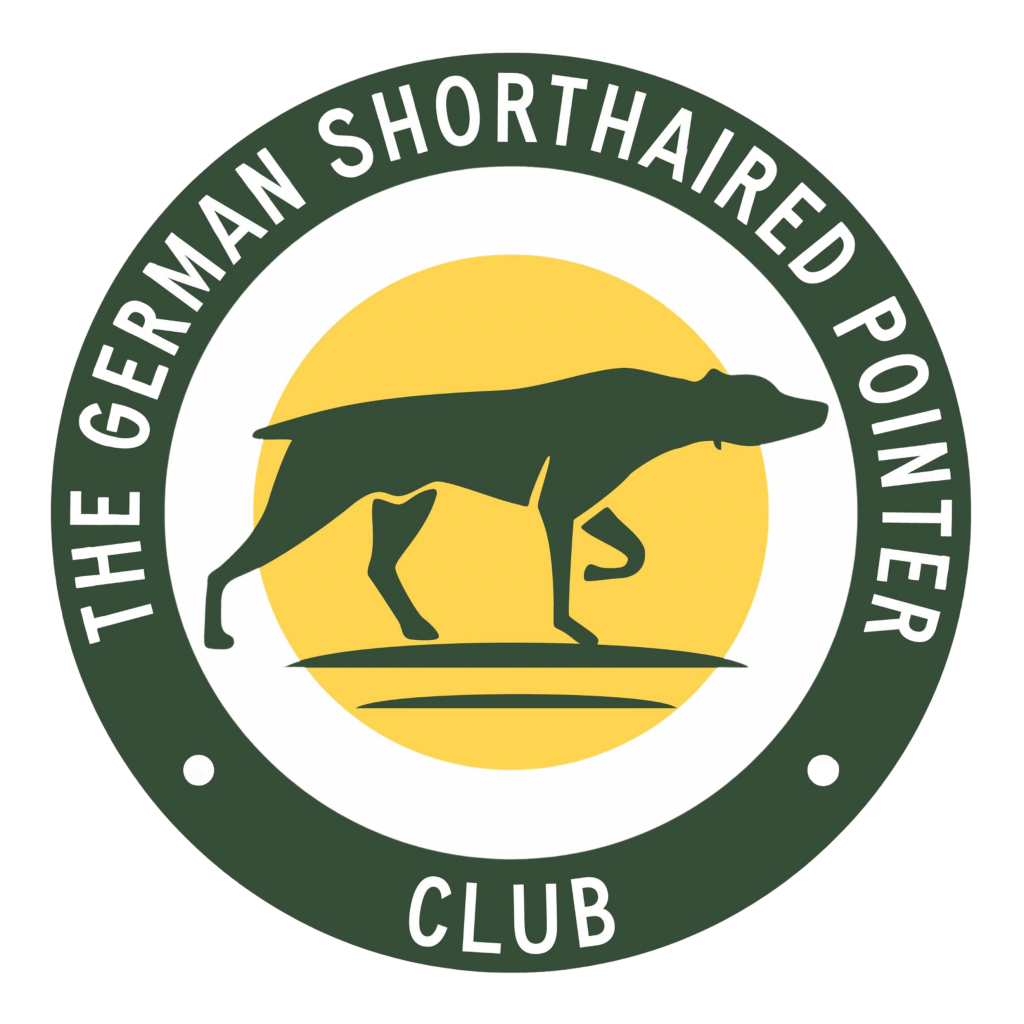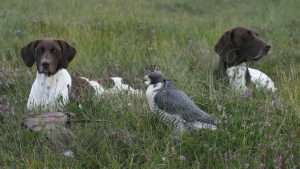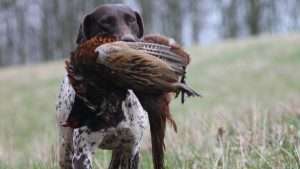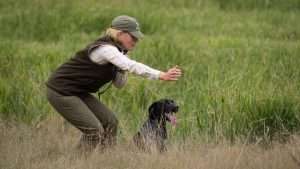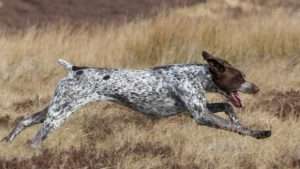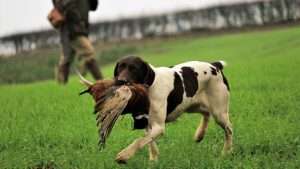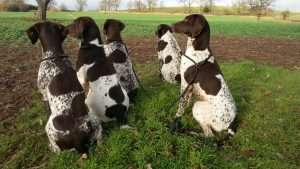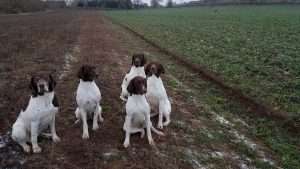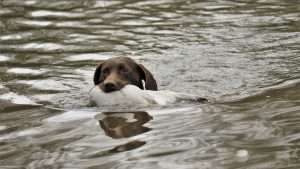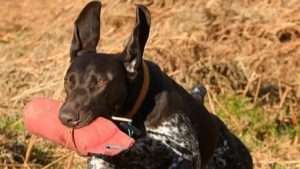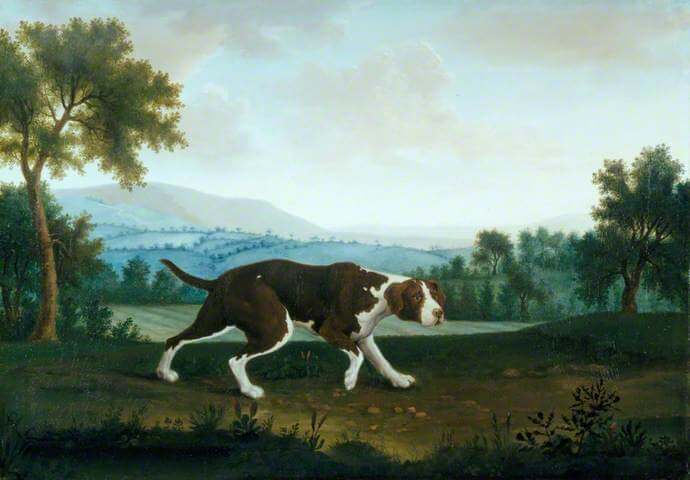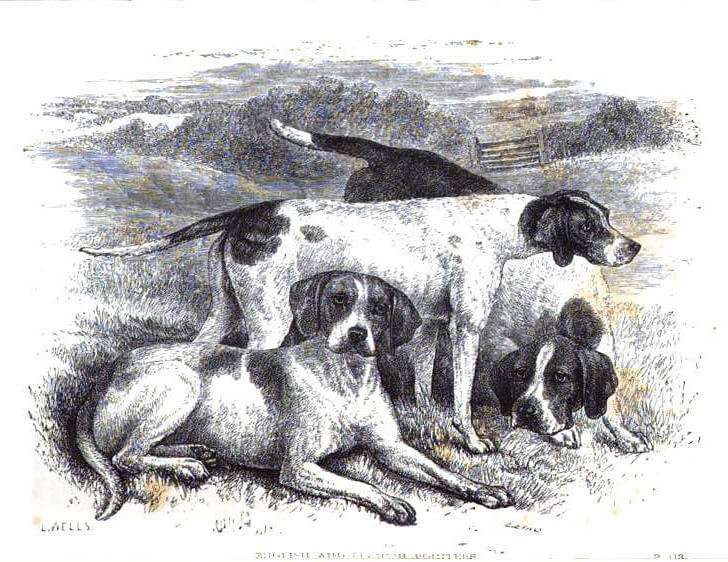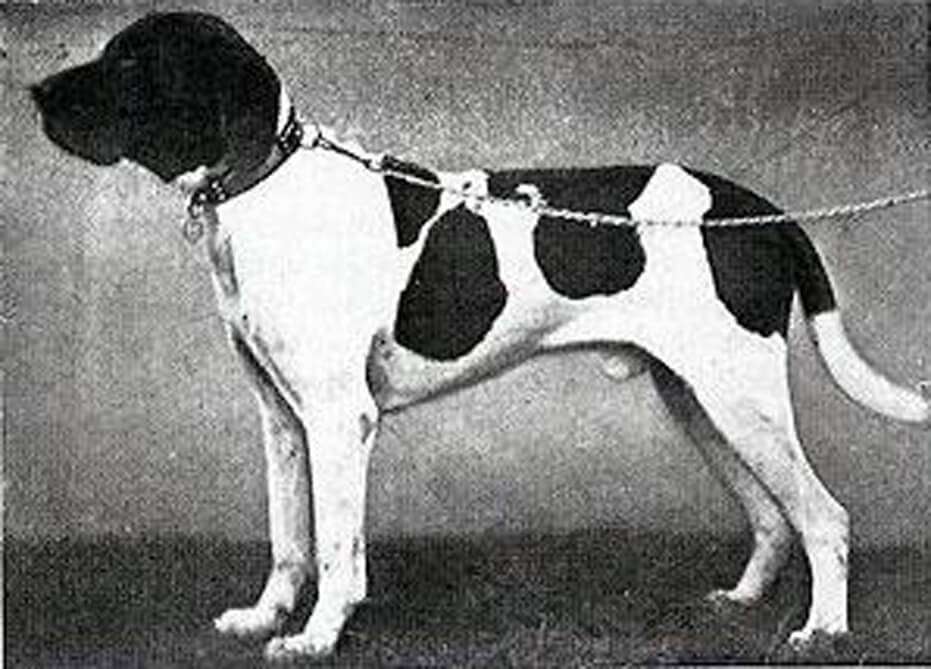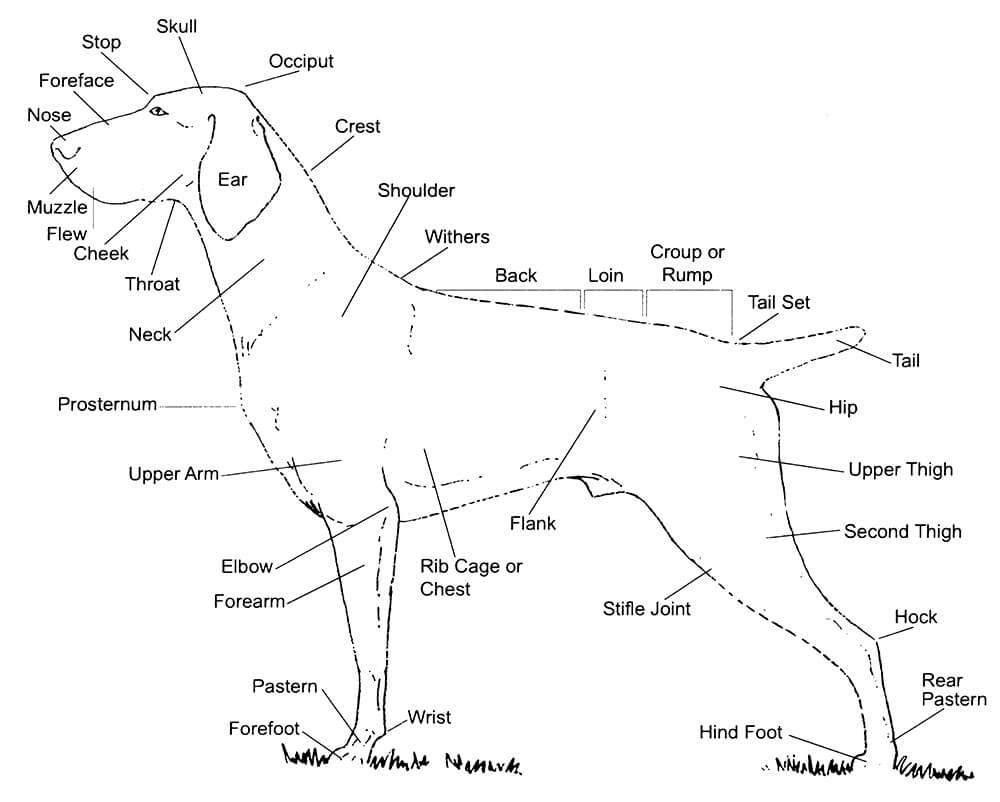An All-Purpose Gundog
The German Shorthaired Pointer is an all purpose gundog… a dog that hunts, points and retrieves. This takes no time at all to read but much more time to explain and understand. The original German breeders had as their ideal:
- A dog that would work in all conditions of weather and cover;
- Would hunt, point and retrieve tenderly on land or in the water;
- Track wounded game;
- Act as a guard against poachers;
- Be brave against predators.
This is only part of the description of a German Shorthaired Pointer. The last two sentences do not appear anywhere in the English standard. What few people new to the world of dogs will understand from the foregoing is that any breeder would consider themselves very lucky if one puppy out of a litter came near the specification in all it’s aspects. I would like to underline one or two words for further consideration:
Intelligence
Any dog bred to do the work of three or more breeds combined must have more intelligence than is the norm in most of the other gundog breeds.
Perseverance
This is a trait especially demanded in both the German and English standards, and it can equally be described as obstinacy.
Guarding
This is a trait that was only sought by the Germans, but it must be born in mind that this can crop up to a great degree in the most unexpected places. I find it a convenient trait in a house-dog, but it can cause problems when allied with character defects. If you would like a guard dog I would suggest one of the working breeds specially bred for this purpose.
Bravery
To be brave against predators can be a polite way of saying they should have killer-instinct, and in Field Trials on the continent, the dogs are required to kill a small animal such as a Fox.
German predators can be much bigger and fiercer than any likely to be met with in this country and it is not unknown for German Shorthaired Pointers to kill cats unless trained not to do so.
Working Homes
Most responsible breeders look first for working homes, then show homes and lastly pet homes. Approximately 1500 German Shorthaired Pointers are registered each year so it is obvious that a great many are going to pet homes. People see some of the gundog breeds leading very quiet sedentary lives and imagine that all gundog breeds are the same, with the same requirements. This is a dangerous generalisation. Some dogs in every breed are going to behave outside the norm for their breed. A German Shorthaired Pointer, by its very breeding for a highly difficult and complex number of expectations, is not going to be a norm within the gundog group. They have been bred to work outside in all weathers, eight hours a day, seven days a week, and some of them are capable of doing just that. They need plenty of varied exercise, they need human love and companionship and they need occupying. They are very like children and are slow to mature, some never do, and their adolescence can be very trying. They are physically strong dogs with strong wills and need consistent handling from the cradle to the grave. Discipline with a capital D and Training with a capital T often stifles the initiative and can produce hard headed dogs. Many are like a piece of elastic, the harder you pull your end the further away the other end becomes.
One of a German Shorthaired Pointers most endearing traits is his love of his people and unless brought up from a very small puppy to kennelling, prefer to live as one of the family. They are remarkable for their companionship traits and do not thrive away from people. Many dogs come into rescue for just this reason. If you have to chastise a German Shorthaired Pointer the “more in sorrow than anger” approach usually works best. They should never be allowed to exercise without supervision. A good home does not need acres of land for him to roam. Nor is it possible to share a picture book garden with one, unless you can fence off a fairly large piece of it for him to enthusiastically turn into the mountains of the moon. They love to dig and their faeces need collecting regularly. If shut outside or inside for long periods on their own they can become very noisy and destructive. They can also use their considerable enterprise and initiative to escape in order to find the company, exercise and interest that they need.
Before taking one on, be very sure that all members of your family are equally keen. Are you young, strong and patient? Do you love long walks? Live within easy reach of the countryside or a large park? This is not the breed for the elderly, no matter how active and young children can get knocked about by a young thoughtless dog. They have an average life expectancy of 10 to 12 years so unless you can see your future stretching before you without overseas postings, or having to change your accommodation into places where pets are not allowed, don’t have one. It will break both yours and the dogs’ heart to part and they are not the easiest breed to re-home.
“A properly reared German Shorthaired Pointer is one of the greatest joys in this life and if they are not in the other then I don’t want to go.” Diane Gossage
History of the German Pointer
The rise of the German Empire under Prussian leadership was in full swing during the mid 1800’s. For the first time, the army, which up to this time had been made up chiefly of the Prussian aristocracy and peasantry, was opened up to the middle class. This, combined with sweeping economic and political changes occurring throughout Europe, led to a rise in the status of the middle class within the Empire.
With this rise came increased privileges regarding land ownership and hunting. In previous centuries, it was usually only the kings, prices and nobles who had the right to hunt, and they owned vast tracks of land for this purpose. However, as the wealth of middle-class Prussia grew during the 1800’s, merchants, professionals, and other middle-class citizens were able to purchase or lease land for themselves on which, of course, they could hunt.
Fulfilling a Need
In Germany dense forests blended with open fields and housed all types of feather and fur, including grouse, rabbit, fox, deer, wolves and wild boar. It was there that the Teutonic hunters wanted to create a breed of hunting dog that could effectively hunt all types of game in all types of terrain that their country had to offer. They wanted a dog with a nose sensitive enough to locate game at an acceptable, useful distance. Because German hunters typically hunted on foot, they also wanted a dog that had enough discipline and inbred instinct to remain staunch on point once the game was located to allow hunters time to close in on the quarry. A hunting partner was needed that would retrieve fallen game for them both on land and in water. In addition, the dog needed to be bold and aggressive enough to interact with and track larger game such as wild cats, foxes and deer within the deep German forests. Finally, and very importantly, these hunters wanted a household companion that could be relied upon to protect the home and those in it effectively when called upon to do so. Keeping all of these qualities in mind, the seed of this dream was effectively planted, and the work was begun to develop such a dog.
Origins and Ancestry
Many different theories exist regarding the actual origins and ancestry of the German Shorthaired Pointer, but most experts believe that the breed development was initiated by a cross between the old Spanish pointer and traditional continental pointers, including the old German pointer and Braque Français. German hunters decided to further cross the breed with tracking hounds such as the German Bloodhound and French Gascon to further enhance scenting ability and to soften the temperament of the emerging breed. The genes of these German tracking hounds also helped to overcome many of the unwanted or undesirable characteristics of the traditional pointers, including reduced trailing ability, a natural aversion for water work, and a noted lack of aggressiveness toward predators.
Even with all these improvements, early breeders were not satisfied. The dogs that were created from the previous crosses were proving to be too slow in the hunt and lacking in true agility. In addition, these hunters liked the scenting prowess that came from the bloodhound, yet didn’t want their new breed to look like a bloodhound. As a result, during the 1860’s, still another cross was made with the English pointer to improve the speed, style, looks and pointing instincts of the breed. The end product of all these effort was a sleek, good-looking, intelligent, loyal and versatile gundog with incredible stamina, an acute sense of smell, a highly developed pointing instinct, and an eagerness to retrieve fallen game either on land or in water. Now the German hunter had a companion that could trail and scent both furred and feathered game, could point and retrieve game birds, and had the size, strength, and courage to interact with larger game such as deer, fox and boar. These dogs were real performers.
The German Shorthaired Pointer in Europe
In 1872 the first GSP made its way into the German Kennel Club Stud Book. His name: Hektor 1 ZK 1. Eleven years later, two GSPs named Nero and Treff competed against each other in the German Derby of 1883. As it turned out, both would end up becoming great foundation dogs for the breed (Nero’s daughter Flora would later produce three offspring named Walden, Waldo and Hertha, all of which can be credited with laying the foundation of many of the pedigree lines in the USA seen today).
The popularity of the new breed soon spread across the European continent. Britain was slow to accept the breed’s popularity, owing to the fact that much of the hunting done here was accomplished on horseback and in open fields. This type of hunting required a dog with a much broader range and speed than the GSP could provide. In addition, national pride in the English pointing breeds undoubtedly contributed to this slow acceptance of the GSP.
In 1887 the GSP did appear on exhibit in England at the Barns Elms Show. However, its introduction was short-lived, and GSPs were not seen with regularity in Britain until after World War II. The Breed’s popularity continued to flourish on the Continent, and in 1891 the Klub Kurzhaar was founded for the purpose of maintaining the standards and guidelines for this new and exciting type of sporting dog.
The UK Breed Standard
A breed standard is the guideline which describes the ideal characteristics, temperament and appearance including the correct colour of a breed and ensures that the breed is fit for function. Absolute soundness is essential. Breeders and judges should at all times be careful to avoid obvious conditions or exaggerations which would be detrimental in any way to the health, welfare or soundness of this breed.
From time to time certain conditions or exaggerations may be considered to have the potential to affect dogs in some breeds adversely, and judges and breeders are requested to refer to the Breed Watch information related to this breed for details of any such current issues. If a feature or quality is desirable it should only be present in the right measure. However, if a dog possesses a feature, characteristic or colour described as unacceptable, it must not be rewarded in the show ring.
General Appearance
Noble, steady dog showing power, endurance and speed, giving the immediate impression of an alert and energetic dog whose movements are well coordinated. Of medium size, with a short back, standing over plenty of ground. Grace of outline, clean-cut head, long sloping shoulders, deep chest, short back, powerful hindquarters, good bone composition, adequate muscle, well carried tail and taut coat.
Characteristics
Dual purpose Pointer/Retriever, very keen nose, perseverance in searching and initiative in game finding, excellence in field, a naturally keen worker, equally good on land and water.
Temperament
Gentle, affectionate and even-tempered. Alert, biddable and very loyal.
Head and Skull
Clean-cut, neither too light nor too heavy, well proportioned to body. Skull sufficiently broad and slightly round. Nasal bone rising gradually from nose to forehead (this more pronounced in dogs) and never possessing a definite stop, but when viewed from side a well defined stop effect due to position of eyebrows. Lips falling away almost vertically from somewhat protruding nose and continuing in a slight curve to corner of mouth. Lips well developed, not over hung. Jaws powerful and sufficiently long to enable the dog to pick up and carry game. Dish-faced and snipy muzzle undesirable. Nose solid brown or black depending on coat colour. Wide nostrils, well opened and soft.
Eyes
Medium size, soft and intelligent, neither protruding nor too deep-set. Varying in shades of brown to tone with coat. Light eye undesirable. Eyelids should close properly.
Ears
Broad and set high; neither too fleshy nor too thin, with a short, soft coat; hung close to head, no pronounced fold, rounded at tip and reaching almost to corner of mouth when brought forward.
Mouth
Teeth sound and strong. Jaws strong, with a perfect, regular and complete scissor bite, i.e. upper teeth closely overlapping lower teeth and set square to the jaws.
Neck
Moderately long, muscular and slightly arched, thickening towards shoulders. Skin not fitting too loosely.
Forequarters
Shoulders sloping and very muscular, top of shoulder blades close; upper arm bones, between shoulder and elbow, long. Elbows well laid back, neither pointing outwards nor inwards. Forelegs straight and lean, sufficiently muscular and strong, but not coarse-boned. Pasterns slightly sloping.
Body
Chest must appear deep rather than wide but in proportion to rest of body; ribs deep and well sprung, never barrel-shaped nor flat; back ribs reaching well down to tuck-up of loins. Chest measurement immediately behind elbows smaller than about a hand’s breadth behind elbows, so that upper arm has freedom of movement. Firm, short back, not arched. Loin wide and slightly arched; croup wide and sufficiently long, neither too heavy nor too sloping starting on a level with back and sloping gradually towards tail. Bones solid and strong. Skin should not fit loosely or fold.
Hindquarters
Hips broad and wide, falling slightly towards tail. Thighs strong and well muscled. Stifles well bent. Hocks square with body and slightly bent, turning neither in nor out. Pasterns nearly upright.
Feet
Compact, close-knit, round to spoon-shaped, well padded, turning neither in nor out. Toes well arched with strong nails.
Tail
Previously customarily docked.
Docked: Starts high and thick growing gradually thinner, customarily docked to medium length by two fifths to half its length. When quiet, tail carried down; when moving, horizontally. Never held high over back or bent.
Undocked: Moderately long, not reaching below hocks. Strong at root, becoming gradually thinner. Carried horizontally or just below line of back.
Gait/Movement
Smooth, lithe gait essential. As gait increases from walk to a faster speed, legs converge beneath body (single tracking). Forelegs reach well ahead, effortlessly covering plenty of ground with each stride and followed by hind legs, which give forceful propulsion.
Coat
Short, flat and coarse to touch, slightly longer under tail.
Colour
Solid liver, liver and white spotted, liver and white spotted and ticked, liver and white ticked, solid black or black and white same variations (not tri-colour).
Size
Dogs: minimum height 58cms (23ins) at withers, maximum height 64cms (25ins) at withers. Bitches: minimum height 53cms (21ins) at withers, maximum height 59cms (23ins) at withers.
Faults
Any departure from the foregoing points should be considered a fault and the seriousness with which the fault should be regarded should be in exact proportion to its degree and its effect upon the health and welfare of the dog and on the dog’s ability to perform its traditional work.
Note
Male animals should have two apparently normal testicles fully descended into the scrotum
Overseas Breed Standards
General Appearance
The German Shorthaired Pointer is a versatile hunter, an all-purpose gun dog capable of high performance in field and water. The judgment of Shorthairs in the show ring reflects this basic characteristic. The overall picture which is created in the observer’s eye is that of an aristocratic, well balanced, symmetrical animal with conformation indicating power, endurance and agility and a look of intelligence and animation. The dog is neither unduly small nor conspicuously large. It gives the impression of medium size, but is like the proper hunter, “with a short back, but standing over plenty of ground.” Symmetry and field quality are most essential. A dog in hard and lean field condition is not to be penalized; however, overly fat or poorly muscled dogs are to be penalized. A dog well balanced in all points is preferable to one with outstanding good qualities and defects. Grace of outline, clean-cut head, sloping shoulders, deep chest, powerful back, strong quarters, good bone composition, adequate muscle, well carried tail and taut coat produce a look of nobility and indicate a heritage of purposefully conducted breeding. Further evidence of this heritage is movement which is balanced, alertly coordinated and without wasted motion.
Size, Proportion, Substance
Size – Height of dogs, measured at the withers, 23 to 25 inches. Height of bitches, measured at the withers, 21 to 23 inches. Deviations of one inch above or below the described heights are to be severely penalized. Weight of dogs 55 to 70 pounds. Weight of bitches 45 to 60 pounds. Proportion – measuring from the forechest to the rearmost projection of the rump and from the withers to the ground, the Shorthair is permissibly either square or slightly longer than he is tall. Substance-thin and fine bones are by no means desirable in a dog which must possess strength and be able to work over any type of terrain. The main importance is not laid so much on the size of bone, but rather on the bone being in proper proportion to the body. Bone structure too heavy or too light is a fault. Tall and leggy dogs, dogs which are ponderous because of excess substance, doggy bitches, and bitchy dogs are to be faulted.
Head
The head is clean-cut, is neither too light nor too heavy, and is in proper proportion to the body. The eyes are of medium size, full of intelligence and expression, good-humored and yet radiating energy, neither protruding nor sunken. The eye is almond shaped, not circular. The preferred color is dark brown. Light yellow eyes are not desirable and are a fault. Closely set eyes are to be faulted. China or wall eyes are to be disqualified. The ears are broad and set fairly high, lie flat and never hang away from the head. Their placement is just above eye level. The ears when laid in front without being pulled, should extend to the corner of the mouth. In the case of heavier dogs, the ears are correspondingly longer. Ears too long or fleshy are to be faulted. The skull is reasonably broad, arched on the side and slightly round on top. Unlike the Pointer, the median line between the eyes at the forehead is not too deep and the occipital bone is not very conspicuous. The foreface rises gradually from nose to forehead. The rise is more strongly pronounced in the dog than in the bitch. The jaw is powerful and the muscles well developed. The line to the forehead rises gradually and never has a definite stop as that of the Pointer, but rather a stop-effect when viewed from the side, due to the position of the eyebrows. The muzzle is sufficiently long to enable the dog to seize game properly and be able to carry it for a long time. A pointed muzzle is not desirable. The depth is in the right proportion to the length, both in the muzzle and in the skull proper. The length of the muzzle should equal the length of skull. A dish-shaped muzzle is a fault. A definite Pointer stop is a serious fault. Too many wrinkles in the forehead is a fault. The nose is brown, the larger the better, and with nostrils well opened and broad. A spotted nose is not desirable. A flesh colored nose disqualifies. The chops fall away from the somewhat projecting nose. Lips are full and deep yet are never flewy. The teeth are strong and healthy. The molars intermesh properly. The bite is a true scissors bite. A perfect level bite is not desirable and must be penalized. Extreme overshot or undershot disqualifies.
Neck, Topline, Body
The neck is of proper length to permit the jaws reaching game to be retrieved, sloping downwards on beautifully curving lines. The nape is rather muscular, becoming gradually larger toward the shoulders. Moderate throatiness is permitted. The skin is close and tight. The chest in general gives the impression of depth rather than breadth; for all that, it is in correct proportion to the other parts of the body. The chest reaches down to the elbows, the ribs forming the thorax show a rib spring and are not flat or slabsided; they are not perfectly round or barrel-shaped. The back ribs reach well down. The circumference of the thorax immediately behind the elbows is smaller than that of the thorax about a hand’s breadth behind elbows, so that the upper arm has room for movement. Tuck-up is apparent. The back is short, strong, and straight with a slight rise from the root of the tail to the withers. The loin is strong, is of moderate length, and is slightly arched. An excessively long, roached or swayed back must be penalized. The hips are broad with hip sockets wide apart and fall slightly toward the tail in a graceful curve. A steep croup is a fault. The tail is set high and firm, and must be docked, leaving approximately 40 percent of its length. The tail hangs down when the dog is quiet and is held horizontally when he is walking. The tail must never be curved over the back toward the head when the dog is moving. A tail curved or bent toward the head is to be severely penalized.
Forequarters
The shoulders are sloping, movable, and well covered with muscle. The shoulder blades lie flat and are well laid back nearing a 45 degree angle. The upper arm (the bones between the shoulder and elbow joint) is as long as possible, standing away somewhat from the trunk so that the straight and closely muscled legs, when viewed from the front, appear to be parallel. Elbows which stand away from the body or are too close result in toes turning inwards or outwards and must be faulted. Pasterns are strong, short and nearly vertical with a slight spring. Loose, short-bladed or straight shoulders must be faulted. Knuckling over is to be faulted. Dewclaws on the forelegs may be removed. The feet are compact, close-knit and round to spoon-shaped. The toes are sufficiently arched and heavily nailed. The pads are strong, hard and thick.
Hindquarters
Thighs are strong and well muscled. Stifles are well bent. Hock joints are well angulated and strong with straight bone structure from hock to pad. Angulation of both stifle and hock joint is such as to achieve the optimal balance of drive and traction. Hocks turn neither in nor out. Cowhocked legs are a serious fault.
Coat
The hair is short and thick and feels tough to the hand; it is somewhat longer on the underside of the tail and the back edges of the haunches. The hair is softer, thinner and shorter on the ears and the head. Any dog with long hair in the body coat is to be severely penalized.
Color
The coat may be of solid liver or a combination of liver and white such as liver and white ticked, liver patched and white ticked, or liver roan. A dog with any area of black, red, orange, lemon or tan, or a dog solid white will be disqualified.
Gait
A smooth lithe gait is essential. It is to be noted that as gait increases from the walk to a faster speed, the legs converge beneath the body. The tendency to single track is desirable. The forelegs reach well ahead as if to pull in the ground without giving the appearance of a hackney gait. The hindquarters drive the back legs smoothly and with great power.
Temperament
The Shorthair is friendly, intelligent, and willing to please. The first impression is that of a keen enthusiasm for work without indication of nervous or flightly character.
Disqualifications
China or wall eyes. Flesh colored nose. Extreme overshot or undershot. A dog with any area of black, red, orange, lemon, or tan, or a dog solid white.
Approved August 11, 1992
Effective September 30, 1992
Secretariat General: 13, Place Albert 1er B – 6530 Thuin (Belgique)
25.04.2001/EN. FCI-Standard N° 119
German Shorthaired Pointing Dog (Deutsch Kurzhaar)
Translation: Walter Schicker
Origin: Germany
Date of publication of the official valid: 25.10.2000.
Utilization: Versatile hunting dog
Section 1.1 Continental Pointing Dogs « Braque » Type.
With working trial.
Brief Historical Summary:
The history of the German Shorthaired Pointing Dog starts with the dogs which were used for the hunt with nets on feathered game, especially in the Mediterranean countries, and in combination with falconry. Via France, Spain and Flanders the Pointers came to the German courts. The most important distinctive feature of these dogs was their pointing performance. After the first double-barrelled gun was made (1750), a pointing dog was even more required. In full sight of the dog «game birds in flight» were shot. That was the beginning of the transition from a mere pointer to a versatile gundog. As a fundamental basis for the structure and development of the breed the «Zuchtbuch Deutsch-Kurzhaar» (Studbook) has been published since 1897. It was Prince Albrecht zu Solms-Braunfeld who compiled breed characteristics, judging rules for conformation and finally also simple trial regulations for hunting dogs. Today the German Shorthaired Pointing Dog still passes through the filter of elaborated breeding- and trial regulations. The standard stipulates the consitution of the German Shorthaired Pointing Dog, as a versatile hunting dog, which enables him to perform all requirements in connection with hunting activities, even when advanced in age.
General Appearance:
A dog of noble and balanced appearance, the conformation of which ensures strength, endurance and speed. Proud attitude, smooth outlines, lean head, well carried tail, firm shiny coat and well reaching, harmonious strides emphasize its nobility.
Important Proportions:
Length of body should slightly exceed height at withers.
Behaviour/Temperament:
Firm, balanced, reliable, restrained temperament, neither nervous nor shy or aggressive.
Head:
Lean, well defined, neither too light nor too heavy; as to strength and length, it matches the substance and the sex of the dog.
Cranial Region:
Skull: Moderately wide, flatly rounded, scarcely pronounced occipital bone, frontal furrow not too deep, noticeably developed superciliary ridges.
Stop: Moderately defined.
Facial Region:
Nose: Somewhat protruding. Nostrils sufficiently wide, broad and mobile. Basically brown, however black in black or black roan dogs. A flesh-coloured or spotted nose is only permissible in dogs with white as basic colour.
Muzzle: Long, broad, deep and strong in order to enable the dog’s correct carrying of game. Viewed from the side the nasal bridge shows a slight curvature in all transitions from a nobly constructed ram’s nose to a slight rise above the straight line – more prominent in males. A totally straight nasal bridge, although still acceptable, is less attractive; a concave bridge (dish-face) is a serious fault.
Lips: Tight fitting, not too pendulous, good pigmentation. The nasolabial line slopes almost vertically and then continues in a flat arch to the moderately pronounced corner of the lips.
Jaws/Teeth: Strong jaws with a perfect, regular and complete scissor bite. The upper inscisors should reach over the lower incisors without gap and the teeth should be positioned vertically in the jaws. 42 sound teeth, in accordance with the teeth formula.
Cheeks: Strong, well muscled.
Eyes: Of medium size, neither protruding nor deep set. The ideal colour is dark brown. Eyelids tight fitting.
Ears: Moderately long, set on high and broad, flat and without twisting hanging down close to the head, bluntly rounded at the tip. Neither too fleshy nor too thin. When brought forward they are supposed to reach more or less the corner of the lips.
Neck:
Length in harmony with general appearance of the dog, progressively thickening towards the body. Very muscular and slightly crested nape. Tight fitting skin of throat.
Body:
Topline: Straight and slightly sloping.
Withers: Well defined.
Back: Firm and muscular. Vertebral processes should be covered by muscles.
Loin: Short, broad, muscular, straight or slightly arched. Transition from back to loin tight and well knit.
Croup: Broad and long enough, not abruptly slanting, but slightly slanting towards the tail, well muscled.
Chest: Somewhat deeper than broad with well defined forechest, with the sternum reaching back as far as possible. Sternum and elbow joint on the same level. Ribs well sprung, neither flat nor barrel-shaped. False ribs well reaching down.
Underline: With elegant arch, slightly tucked up towards rear, dry.
Tail:
Set high, strong at the root and then tapering, of medium length. About halfway docked for hunting purposes. At rest hanging down; in movement horizontal, neither carried too high above the backline nor extremely bent. (In countries where tail docking is prohibited by law, the tail can remain in its natural shape. It should reach down as far as the hocks and be carried straight or slightly sabre tail fashion).
Limbs Forequarters:
General appearance: Viewed from the front, straight and parallel; viewed from the side, the legs are well placed under the body.
Shoulders: Shoulder blades well laid back, well attached to chest, and strongly muscled. Shoulder blade and upper arm well angulated.
Upper arm: As long as possible, well muscled and dry.
Elbow: Close but not too tight to body, neither turned in nor out, well set back.
Forearm: Straight and sufficiently muscled. Strong bone, not too coarse.
Pastern joint: Strong.
Pastern: Minimal angulation of pastern and forearm, never standing upright.
Forefeet: Round to spoon shaped, with well tight and adequately arched toes. Strong toenails. Tough, resistant pads. Feet set parallel, neither turned in nor out, in stance as well as in movement.
Hindquarters:
General appearance: Viewed from behind straight and parallel. Good angulations in stifles and hocks, strong bone.
Upper thigh: Long, broad and muscular, with good angulation between pelvis and femur.
Stifle: Strong, with good angulation of upper- and lower thigh.
Lower thigh: Long, muscular with clearly visible tendons. Good angulation between lower thigh and hocks.
Hock joint: Strong.
Hocks: Strong, vertical.
Hind feet: Round to spoon shaped, with well tight and adequately arched toes. Strong toenails. Tough, resistant pads. Foot set parallel, neither turned in nor out, in stance as well as in movement.
Gait:
Well extended strides, with forceful propulsion from the hindquarters and adequate reach of the forelimbs. Front and hind legs moving straight and parallel. The dog is carrying himself in a proud attitude. Pacing gait is not desirable.
Skin:
Close and tight, not wrinkly.
Coat Hair:
Short and dense, rough and hard to the touch. Somewhat thinner and shorter on the head and ears, not remarkably longer at the underside of the tail. Should cover the whole body.
Colour:
- Solid brown, without markings.
- Brown with small white or flecked markings at chest and legs.
- Dark brown roan, with brown head, brown patches or specks. The basic colour of such a dog is not brown mixed with white or white with brown, but the coat shows such an even intensive mixture of brown and white which results in that kind of inconspicuous exterior of the dog ever so valuable for the practical hunt. At the inner sides of the hind legs as well as at the tip of the tail the colour is often lighter.
- Light brown roan with brown head, brown patches, specks or without patches. In this colouring the brown hairs are fewer, the white hairs are predominant.
- White with brown head markings, brown patches or specks.
- Black colour in the same nuances as the brown, respectively the brown roan colours.
- Yellow tan markings are permissible.
- Blaze, fleck and speckled flews are permissible.
Size:
Height at the withers: Dogs 62 to 66 cm.
Bitches 58 to 63 cm.
Faults:
Any departure from the foregoing points should be considered a fault and the seriousness with which the fault should be regarded should be in exact proportion to its degree and its effect upon the health and welfare of the dog.
- Faults in attitude, not according or typical to gender.
- Muzzle too short.
- Flews too heavy or too thin.
- From the total of 4 PM 1 and 2 M3 only two teeth may be missing.
- Eyes too light. Yellowish «bird of prey» eyes.
- Ears too long, too short, too heavy, set on too narrow or twisted.
- Loose skin at throat.
- Slight roach back.
- Rump too short.
- Chest too deep.
- Tail strongly bent or carried too high above the topline.
- Elbows turned in or out. Feet turned in or out; forelegs standing close or wide.
- Hindquarters too straight.
- Slightly bow-legged, slightly cow-hocked or close hocks.
Serious Faults:
- Clumsy, lymphatic, coarse conformation.
- Marked stop.
- Flesh-coloured or flecked nose (except when basic colour of coat is white).
- Snipy muzzle, concave bridge of the nose (dish-face).
- Pincer bite or partial pincer bite (For dogs older than 4 years a socalled pincer bite due to age shall not affect evaluation as long as a «Deutsch-Kurzhaar-Club» has certified that at a previous show a correct bite was confirmed).
- Distinct roach back, slight swayback.
- Considerable lack in depth of chest. Poorly developed forechest. Ribs too flat or barrel shaped.
- Distinctly turned in or turned out elbows.
- Weak and down on pasterns.
- Pastern totally vertical.
- Distinctly cow-hocked or bow-legged, in stance as well as in movement.
- Overbuilt hindquarters.
- Flat feet.
- Spread toes.
- Clumsy gait.
- Deviation of more than 2 cm from the given height at the withers.
Disqualifying Faults:
- Aggressive or overly shy dogs.
- Any dog clearly showing physical or behavioural abnormalities shall be disqualified.
- Distinctly non-typical gender characteristics.
- Absence of more than 2 teeth from the total of 4 PM 1 and 2 M3. Absence of 1 tooth or more teeth other than PM 1 and M3. Non visible teeth have to be considered as missing except when certified by a «Deutsch-Kurzhaar-Club» that at a previous show or trial their existence was confirmed.
- Overshot and undershot bite, wry mouth as well as all intergrades.
- Any surplus teeth arranged outside the dental arch.
- Cleft palate and hare lip.
- Excessively loose eyelids, ectropion, entropion, distichiasis (double row of eyelashes).
- Excessive swayback, malformation of the spine.
- Any malformation of the chest, e.g. «clipped sternum» (short sternum blending abruptly into the abdominal line).
- Dewclaws with or without bony skeleton.
- Weak character.
N.B:
- Male animals should have two apparently normal testicles fully descended into the scrotum.
- Only functionally and clinically healthy dogs, with breed typical conformation should be used for breeding.
The latest amendments are in bold characters.
Breed Health
The contents of this section are being evaluated and will be add in full at a later date.
Useful resources:
The Breed Health Co-ordinator for GSP is:
Linda Heath
Click here to email or call – 07825 776121
The Kennel Club breed page for GSP that includes some health information:
https://www.thekennelclub.org.uk/search/breeds-a-to-z/breeds/gundog/german-shorthaired-pointer/
GSP Rescue UK
Rescue, rehabilitation & rehoming for German Shorthaired Pointers
GSP Rescue UK is an organisation dedicated to the welfare of German Shorthaired Pointers through rescue, rehabilitation, rehoming, and education.
We are funded entirely on donations and our activities are run by volunteers. GSP Rescue UK are a non-profit organisation registered as a charity with the Charity Commission. We are very grateful for any donation, no matter how big or small,whether it be money, goods or services. Every penny is a penny towards the help of a GSP.
GSP Rescue UK is the only breed rescue officially recognised by The German Shorthaired Pointer Club, The Central and Southern GSP Society, The GSP Association and The Kennel Club.
From sending donations to adopting a dog, any help is greatly appreciated. If you would like to get involved here are some examples of ways to help:
- EasyFundraising – earn money for us every time you shop online. You can also donate for free when you sign up to our EasyFundraising account. It costs nothing to join, and we receive donations every time you shop online via the EasyFundraising site – https://www.easyfundraising.org.uk/causes/gsprescueuk/
- Participate in our fundraising events
- Donate items to auction or raffle
- Donations via PayPal via donations@gsprescue-uk.org.uk
- Collect used stamps
If you would like to start collecting stamps for us, please cut them from packaging or envelopes leaving a 1cm border all around the stamp.
Please send stamps to: GSP Rescue UK-Stamp Appeal, 6 Forge Row, Gilwern, Abergavenney, Monmouthshire.NP7 0HA
For details on the rescue and rehoming of German Shorthaired Pointers:
- Visit the website at www.gsprescue-uk.org.uk
- Call us on 01873 831879
- Follow us on Facebook – GSP Rescue UK
- Email: enquiries@gsprescue-uk.org.uk
Registered Charity Number 1172457
HMRC Number EW62428
